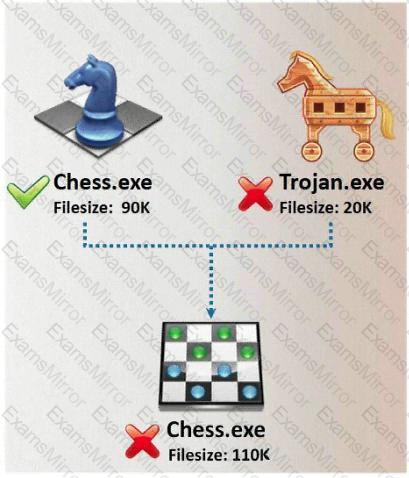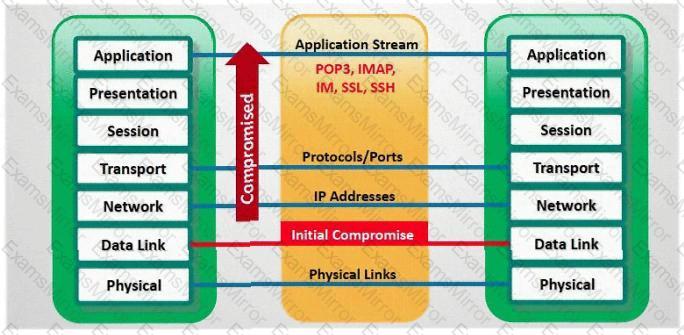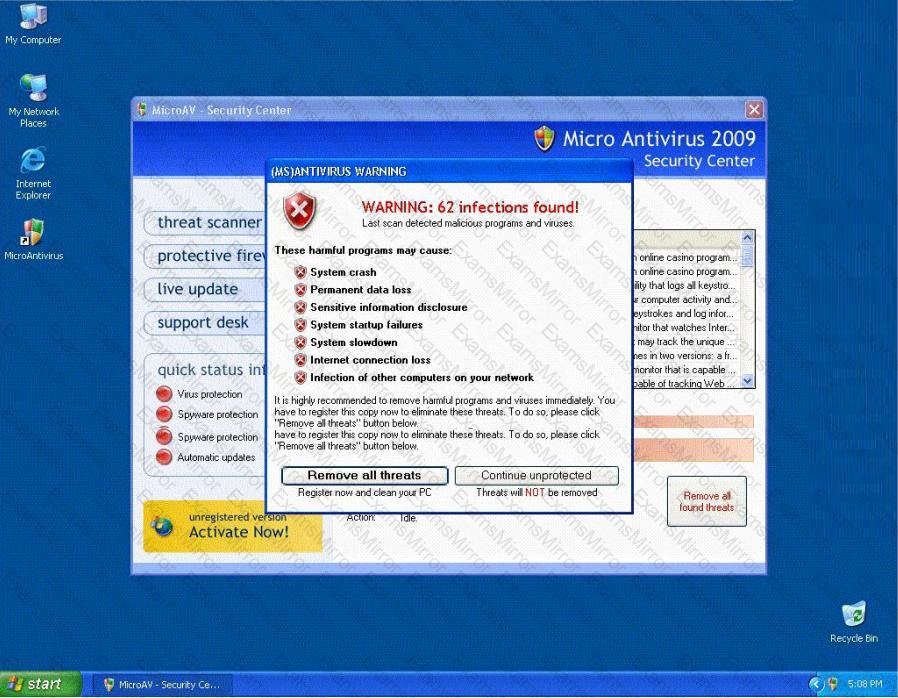New Year Special Limited Time 70% Discount Offer - Ends in 0d 00h 00m 00s - Coupon code = getmirror
Pass the GAQM Certified Ethical Hacker CEH CEH-001 Questions and answers with ExamsMirror
Exam CEH-001 Premium Access
View all detail and faqs for the CEH-001 exam
591 Students Passed
88% Average Score
91% Same Questions
In what stage of Virus life does a stealth virus gets activated with the user performing certain actions such as running an infected program?
In TCP communications there are 8 flags; FIN, SYN, RST, PSH, ACK, URG, ECE, CWR. These flags have decimal numbers assigned to them:
FIN = 1
SYN = 2
RST = 4
PSH = 8
ACK = 16
URG = 32
ECE = 64
CWR = 128
Jason is the security administrator of ASPEN Communications. He analyzes some traffic using Wireshark and has enabled the following filters.

What is Jason trying to accomplish here?
Which type of scan does NOT open a full TCP connection?
You want to hide a secret.txt document inside c:\windows\system32\tcpip.dll kernel library using ADS streams. How will you accomplish this?
In Trojan terminology, what is required to create the executable file chess.exe as shown below?

In which part of OSI layer, ARP Poisoning occurs?

An attacker has successfully compromised a remote computer. Which of the following comes as one of the last steps that should be taken to ensure that the compromise cannot be traced back to the source of the problem?
You are the security administrator of Jaco Banking Systems located in Boston. You are setting up e-banking website (http://www.ejacobank.com) authentication system. Instead of issuing banking customer with a single password, you give them a printed list of 100 unique passwords. Each time the customer needs to log into the e-banking system website, the customer enters the next password on the list. If someone sees them type the password using shoulder surfing, MiTM or keyloggers, then no damage is done because the password will not be accepted a second time. Once the list of 100 passwords is almost finished, the system automatically sends out a new password list by encrypted e-mail to the customer.
You are confident that this security implementation will protect the customer from password abuse.
Two months later, a group of hackers called "HackJihad" found a way to access the one-time password list issued to customers of Jaco Banking Systems. The hackers set up a fake website (http://www.e-jacobank.com) and used phishing attacks to direct ignorant customers to it. The fake website asked users for their e-banking username and password, and the next unused entry from their one-time password sheet. The hackers collected 200 customer 's username/passwords this way. They transferred money from the customer's bank account to various offshore accounts.
Your decision of password policy implementation has cost the bank with USD 925, 000 to hackers. You immediately shut down the e-banking website while figuring out the next best security solution
What effective security solution will you recommend in this case?
This IDS defeating technique works by splitting a datagram (or packet) into multiple fragments and the IDS will not spot the true nature of the fully assembled datagram. The datagram is not reassembled until it reaches its final destination. It would be a processor-intensive task for IDS to reassemble all fragments itself, and on a busy system the packet will slip through the IDS onto the network. What is this technique called?
Bob has set up three web servers on Windows Server 2008 IIS 7.0. Bob has followed all the recommendations for securing the operating system and IIS. These servers are going to run numerous e-commerce websites that are projected to bring in thousands of dollars a day. Bob is still concerned about the security of these servers because of the potential for financial loss. Bob has asked his company's firewall administrator to set the firewall to inspect all incoming traffic on ports 80 and 443 to ensure that no malicious data is getting into the network.
Why will this not be possible?
Lori is a Certified Ethical Hacker as well as a Certified Hacking Forensics Investigator working as an IT security consultant. Lori has been hired on by Kiley Innovators, a large marketing firm that recently underwent a string of thefts and corporate espionage incidents. Lori is told that a rival marketing company came out with an exact duplicate product right before Kiley Innovators was about to release it. The executive team believes that an employee is leaking information to the rival company. Lori questions all employees, reviews server logs, and firewall logs; after which she finds nothing. Lori is then given permission to search through the corporate email system. She searches by email being sent to and sent from the rival marketing company.
She finds one employee that appears to be sending very large email to this other marketing company, even though they should have no reason to be communicating with them. Lori tracks down the actual emails sent and upon opening them, only finds picture files attached to them. These files seem perfectly harmless, usually containing some kind of joke. Lori decides to use some special software to further examine the pictures and finds that each one had hidden text that was stored in each picture.
What technique was used by the Kiley Innovators employee to send information to the rival marketing company?
Jason works in the sales and marketing department for a very large advertising agency located in Atlanta. Jason is working on a very important marketing campaign for his company's largest client. Before the project could be completed and implemented, a competing advertising company comes out with the exact same marketing materials and advertising, thus rendering all the work done for Jason's client unusable. Jason is questioned about this and says he has no idea how all the material ended up in the hands of a competitor.
Without any proof, Jason's company cannot do anything except move on. After working on another high profile client for about a month, all the marketing and sales material again ends up in the hands of another competitor and is released to the public before Jason's company can finish the project. Once again, Jason says that he had nothing to do with it and does not know how this could have happened. Jason is given leave with pay until they can figure out what is going on.
Jason's supervisor decides to go through his email and finds a number of emails that were sent to the competitors that ended up with the marketing material. The only items in the emails were attached jpg files, but nothing else. Jason's supervisor opens the picture files, but cannot find anything out of the ordinary with them.
What technique has Jason most likely used?
Fake Anti-Virus, is one of the most frequently encountered and persistent threats on the web. This malware uses social engineering to lure users into infected websites with a technique called Search Engine Optimization.
Once the Fake AV is downloaded into the user's computer, the software will scare them into believing their system is infected with threats that do not really exist, and then push users to purchase services to clean up the non-existent threats.
The Fake AntiVirus will continue to send these annoying and intrusive alerts until a payment is made.

What is the risk of installing Fake AntiVirus?
Peter extracts the SID list from Windows 2008 Server machine using the hacking tool "SIDExtracter". Here is the output of the SIDs:

From the above list identify the user account with System Administrator privileges?
Which of the following countermeasure can specifically protect against both the MAC Flood and MAC Spoofing attacks?
The SYN flood attack sends TCP connections requests faster than a machine can process them.
Attacker creates a random source address for each packet
SYN flag set in each packet is a request to open a new connection to the server from the spoofed IP address
Victim responds to spoofed IP address, then waits for confirmation that never arrives (timeout wait is about 3 minutes)
Victim's connection table fills up waiting for replies and ignores new connections
Legitimate users are ignored and will not be able to access the server
How do you protect your network against SYN Flood attacks?
Steven the hacker realizes the network administrator of Acme Corporation is using syskey in Windows 2008 Server to protect his resources in the organization. Syskey independently encrypts the hashes so that physical access to the server, tapes, or ERDs is only first step to cracking the passwords. Steven must break through the encryption used by syskey before he can attempt to use brute force dictionary attacks on the hashes. Steven runs a program called "SysCracker" targeting the Windows 2008 Server machine in attempting to crack the hash used by Syskey. He needs to configure the encryption level before he can launch the attack. How many bits does Syskey use for encryption?
Which type of hacker represents the highest risk to your network?
You receive an e-mail with the following text message.
"Microsoft and HP today warned all customers that a new, highly dangerous virus has been discovered which will erase all your files at midnight. If there's a file called hidserv.exe on your computer, you have been infected and your computer is now running a hidden server that allows hackers to access your computer. Delete the file immediately. Please also pass this message to all your friends and colleagues as soon as possible."
You launch your antivirus software and scan the suspicious looking file hidserv.exe located in c:\windows directory and the AV comes out clean meaning the file is not infected. You view the file signature and confirm that it is a legitimate Windows system file "Human Interface Device Service".
What category of virus is this?
Which of the following type of scanning utilizes automated process of proactively identifying vulnerabilities of the computing systems present on a network?
TOP CODES
Top selling exam codes in the certification world, popular, in demand and updated to help you pass on the first try.
